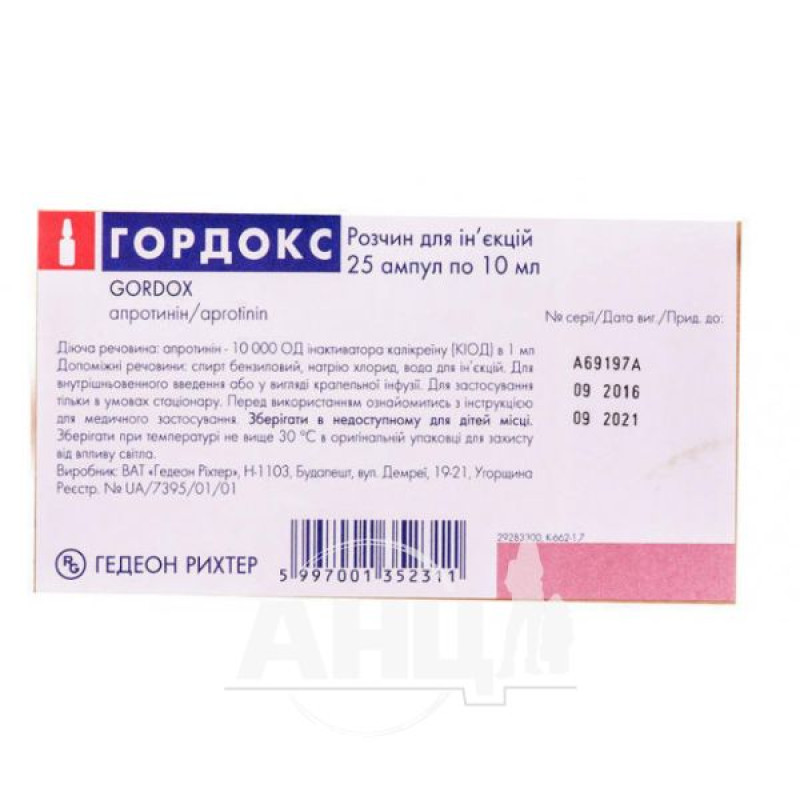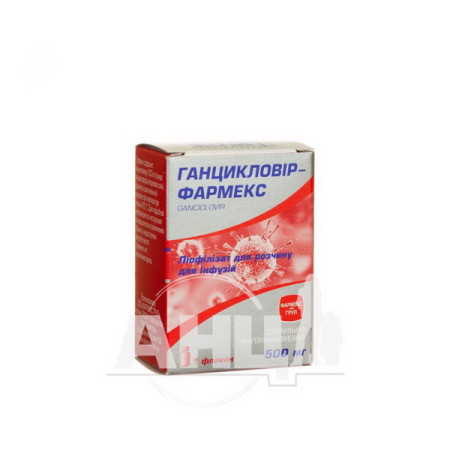Gordox solution for injection 10,000 kIU/ml ampoule 10 ml No. 25

Pharmacological properties
Pharmacodynamics. Aprotinin is a broad-spectrum protease inhibitor molecule with antifibrinolytic activity. Forming a reversible stoichiometric enzyme-inhibitor complex, aprotinin in humans inhibits trypsin, plasmin, kallikrein in blood plasma and tissues, which leads to inhibition of fibrinolysis. In addition, it inhibits the contact phase of blood coagulation activation, is a factor in initiating the coagulation process and stimulating fibrinolysis.
Aprotinin is used in operations under conditions of artificial blood circulation, as it reduces inflammatory reactions, which leads to a decrease in the need for allogeneic blood transfusion and blood loss, as well as to a decrease in the need for repeated examination of the mediastinum for bleeding.
In patients undergoing coronary artery bypass grafting, the incidence of plasma creatinine elevations of ≥0.5 mg/dL from baseline was significantly higher in the full-dose aprotinin group than in the placebo group. In most cases, postoperative renal impairment was reversible and not serious, and the incidence of plasma creatinine elevations ≥2 mg/dL from baseline was similar in the full-dose aprotinin and placebo groups.
Pharmacokinetics. After intravenous administration, aprotinin is rapidly distributed throughout the extracellular space, which is accompanied by a rapid decrease in the concentration of aprotinin in the blood plasma, T ½ is 0.3-0.7 hours. Later, in particular 5 hours after administration, the terminal elimination phase occurs, in which T ½ is 5-10 hours.
The placenta is probably not completely impermeable to aprotinin, but penetration is apparently extremely slow.
Metabolism, elimination and excretion. The aprotinin molecule in the kidneys is cleaved by lysosomal enzymes into shorter peptides or amino acids. In humans, less than 5% of the administered dose of aprotinin is excreted in the urine. After intravenous administration of 131 I-labeled aprotinin to healthy volunteers, 25-40% of the labeled substance is excreted in the urine within 48 hours as metabolites. These metabolites do not have enzyme-inhibiting activity.
There are no data on the use of the drug in patients with end-stage renal failure, however, no clinically significant pharmacokinetic changes or obvious side effects have been identified in patients with impaired renal function. Therefore, no specific dose adjustment is required in such cases.
Indication
Aprotinin is indicated for prophylaxis to reduce postoperative blood loss and the need for blood transfusion in adult patients at high risk of major blood loss undergoing isolated cardiopulmonary bypass (i.e. coronary artery bypass grafting that is not combined with other cardiovascular interventions).
Aprotinin should be used only after careful consideration of the benefits and risks, and with consideration of the availability of alternative treatments.
Application
Before administering the drug, all patients should be tested for IgG antibodies specific to aprotinin (see Contraindications).
Except in cases where the nature of the prescriptions differs, the following doses of the drug are recommended for adult patients.
Test dose. Due to the risk of allergic (anaphylactic) reaction, all patients should be administered 10,000 CMU of aprotinin (1 ml) intravenously at least 10 minutes before the initial dose. If the initial dose of 1 ml does not cause an allergic reaction, then the therapeutic dose can be administered.
H1 and H2 receptor antagonists can be administered 15 minutes before the aprotinin test. Facilities for standard emergency treatment of anaphylactic and allergic reactions should be available.
Dosage during open-heart surgery (with a cardiopulmonary bypass) to reduce blood loss and the need for blood transfusion. After induction of anesthesia (but before sternotomy), it is recommended to administer a loading dose of 1,000,000-2,000,000 CMU by slow IV injection or infusion over 20-30 minutes. The next dose of 1,000,000-2,000,000 CMU should be administered after the cardiopulmonary bypass is turned on. To avoid physical incompatibility between aprotinin and heparin, which is added to the pump priming solution, each drug should be added to the pump priming solution during recirculation to ensure sufficient dilution of both drugs before mixing with each other. After an initial bolus infusion of high doses, 250,000-500,000 CMU/h should be administered by continuous infusion until the end of the operation.
In general, the total amount of aprotinin administered during the treatment cycle should not exceed 6,000,000 CMU, which is due to the content of benzyl alcohol in the injection solution (see Features of use).
Aprotinin for intravenous administration should be administered through a central venous catheter that should not be used for the administration of any other drug.
The drug can only be administered to patients who are in a supine position; the administration should be carried out slowly (maximum speed - 5-10 ml/min) by intravenous injection or short-term infusion.
According to clinical experience to date, no dose adjustment is required for patients with impaired renal function.
Contraindication
Hypersensitivity to the active substance or to any of the excipients. In patients with IgG antibodies specific for aprotinin, an increased risk of anaphylaxis has been observed during treatment with aprotinin. Therefore, aprotinin therapy is contraindicated in such patients.
If testing for specific IgG antibodies to aprotinin before starting treatment is not possible, but it is assumed that the patient has received aprotinin treatment within the previous 12 months, administration of aprotinin is contraindicated.
Side effects
Summary of the safety profile. The safety of aprotinin has been evaluated in more than 45 phase II-III studies involving more than 3800 patients treated with aprotinin. Overall, 11% of patients treated with aprotinin developed adverse reactions. The most serious adverse reaction was myocardial infarction. Adverse reactions should be evaluated in the context of surgical interventions.
Allergic/anaphylactic reactions. In patients receiving aprotinin for the first time, the development of allergic or anaphylactic reactions is unlikely. In the case of repeated administration, the frequency of allergic (anaphylactic) reactions can reach 5%. In a retrospective analysis of allergic (anaphylactic) reactions, their frequency was found to increase if re-administration was noted within 6 months after the initial treatment (the frequency was 5% for re-exposure within 6 months and 0.9% for re-exposure after 6 months). In addition, in a retrospective analysis, it was found that the frequency of severe anaphylactic reactions was further increased in patients who received aprotinin more than 2 times within 6 months. Even if the patient tolerated repeated treatment with aprotinin well, subsequent administration may cause a severe allergic reaction or, in very rare cases, anaphylactic shock with a fatal outcome.
Symptoms of allergic or anaphylactic reactions:
Cardiovascular system: arterial hypotension;
from the digestive system: nausea;
from the respiratory system: asthma (bronchospasm);
Skin and Appendages: itching, urticaria, rash.
If an allergic reaction develops during injection or infusion, the drug should be discontinued immediately. Standard emergency measures should be used, including the administration of adrenaline, corticosteroids, and infusion therapy.
Cardiovascular system. In patients undergoing coronary artery bypass grafting, no significant differences in the incidence of myocardial infarction compared with placebo were demonstrated. Some studies have shown a trend toward an increase in the incidence of myocardial infarction with aprotinin, while others have shown a decrease.
Since the above studies were not designed to detect differences in the incidence of myocardial infarction, an increase in the likelihood of clinically significant side effects cannot be statistically reliably excluded.
Adverse reactions identified during post-marketing use are marked in italics.
Within each frequency category, adverse reactions are presented in order of decreasing seriousness.
| Systemic disorders and injection site reactions | ||||
| Injection site reactions | Injection or infusion site reactions Thrombophlebitis at the infusion site | |||
| Cardiac disorders | ||||
| Myocardial disorders | Myocardial infarction myocardial ischemia Coronary artery occlusion/thrombosis | |||
| pericardial effusion | pericardial effusion | |||
| vascular disorders | ||||
| Embolisms and thrombosis | thrombosis | Arterial thrombosis (and its forms specific to vital organs, e.g. kidneys, lungs, brain) | pulmonary thromboembolism arteries | |
| Blood and lymphatic system disorders | ||||
| Blood clotting disorders | Internal combustion engine coagulopathy | |||
| Immune system disorders | ||||
| Acute hypersensitivity reactions | allergic reactions Anaphylactic/anaphylactoid reactions | Anaphylactic shock (potentially life-threatening) | ||
| Renal and urinary disorders | ||||
| Kidney dysfunction | OPN renal necrosis tubules oliguria | |||
Special instructions
Treatment with aprotinin may be associated with renal impairment, particularly in patients with renal impairment. In patients undergoing coronary artery bypass grafting, an increase in plasma creatinine levels of 0.5 mg/dl above normal has been observed with aprotinin (see Pharmacological properties). Accordingly, a careful benefit-risk assessment should be considered before prescribing aprotinin to patients with renal impairment or at risk of renal impairment (with concomitant aminoglycoside therapy).
Patients treated with aprotinin had an increased incidence of renal failure and mortality compared with age-matched controls who had a similar medical history and who also underwent thoracic aortic surgery under cardiopulmonary bypass with profound hypothermia. In such cases, aprotinin should be administered only with extreme caution. Appropriate anticoagulant therapy with heparin should be administered.
This medicine contains benzyl alcohol, which may cause anaphylactoid reactions.
A careful benefit-risk assessment is necessary when using aprotinin, especially in patients who have previously used aprotinin (including fibrin sealant containing aprotinin), as they may develop an allergic reaction (see Adverse Reactions). Although most cases of anaphylaxis develop after the administration of the approved dose within 12 months; there are isolated reports of anaphylactic reactions occurring with re-exposure after 12 months. During aprotinin therapy, emergency facilities for the treatment of allergic and anaphylactic reactions should be available.
All patients receiving aprotinin treatment should
There are no reviews for this product.
There are no reviews for this product, be the first to leave your review.
No questions about this product, be the first and ask your question.

